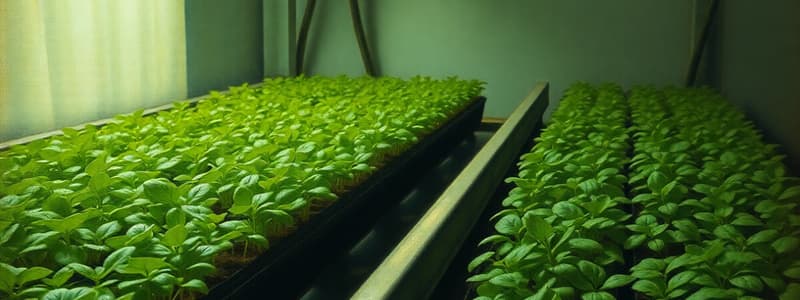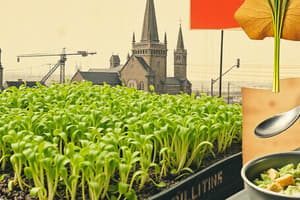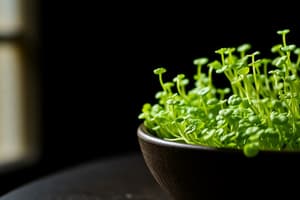Podcast
Questions and Answers
What is the primary difference between traditional NFT systems and fodder systems?
What is the primary difference between traditional NFT systems and fodder systems?
- NFT systems utilize fiber mats as a growing substrate.
- NFT systems use multiple layers.
- Fodder systems involve a single layer of channels.
- Fodder systems have multiple layers. (correct)
What impact does increasing seeding density have on microgreens?
What impact does increasing seeding density have on microgreens?
- Increases total yield but decreases individual plant weight. (correct)
- Decreases overall yield.
- Increases the weight per individual plant.
- Eliminates competition among seedlings.
What is the recommended concentration of nitrogen for enhancing microgreens growth?
What is the recommended concentration of nitrogen for enhancing microgreens growth?
- 5 to 10 ppm.
- 50 to 75 ppm.
- 150 to 300 ppm.
- 75 to 150 ppm. (correct)
What temperature range is commonly used for growing microgreens in controlled environments?
What temperature range is commonly used for growing microgreens in controlled environments?
What is the role of supplemental CO2 in microgreens cultivation?
What is the role of supplemental CO2 in microgreens cultivation?
Which of the following diseases is significant in microgreens production?
Which of the following diseases is significant in microgreens production?
How should microgreens be stored to maximize shelf life after harvesting?
How should microgreens be stored to maximize shelf life after harvesting?
What is a common practice for marketing microgreens?
What is a common practice for marketing microgreens?
What is the significance of light intensity for growing microgreens?
What is the significance of light intensity for growing microgreens?
Which of the following is NOT a necessary practice for microgreens?
Which of the following is NOT a necessary practice for microgreens?
What is one of the main differences between NFT systems for lettuce and those used for microgreens?
What is one of the main differences between NFT systems for lettuce and those used for microgreens?
Which system is specifically used for producing hydroponic fodder for livestock?
Which system is specifically used for producing hydroponic fodder for livestock?
What substrate is commonly used for growing microgreens in a hydroponic system?
What substrate is commonly used for growing microgreens in a hydroponic system?
What is the primary consideration when sowing seeds for microgreen production?
What is the primary consideration when sowing seeds for microgreen production?
When are microgreens typically harvested during their growth cycle?
When are microgreens typically harvested during their growth cycle?
Which of the following statements about microgreens is true?
Which of the following statements about microgreens is true?
What happens to individual plant weight as seeding density increases?
What happens to individual plant weight as seeding density increases?
What is a common production method for microgreens that uses wider channels?
What is a common production method for microgreens that uses wider channels?
Which container is suitable for growing microgreens?
Which container is suitable for growing microgreens?
Why might some channels in a microgreens system be covered with polystyrene boards?
Why might some channels in a microgreens system be covered with polystyrene boards?
Flashcards
Microgreen Production Systems
Microgreen Production Systems
Various systems are used to grow microgreens, including nutrient film technique (NFT)-type systems adapted for wider channels and hydroponic fodder systems with multiple layers.
NFT System for Microgreens
NFT System for Microgreens
A modified nutrient film technique (NFT) system using wider channels compared to standard NFT methods for lettuce and herbs.
Hydroponic Fodder System
Hydroponic Fodder System
A hydroponic system used for growing microgreens in multiple layers via a fiber mat substrate, differing from single-layer NFT systems.
Seeding Density and Microgreens
Seeding Density and Microgreens
Signup and view all the flashcards
Microgreen Harvesting
Microgreen Harvesting
Signup and view all the flashcards
Microgreens and Propagation
Microgreens and Propagation
Signup and view all the flashcards
Microgreen Growing Substrate
Microgreen Growing Substrate
Signup and view all the flashcards
Traditional NFT Channel Width
Traditional NFT Channel Width
Signup and view all the flashcards
Microgreen Channel Width
Microgreen Channel Width
Signup and view all the flashcards
Microgreen Characteristics
Microgreen Characteristics
Signup and view all the flashcards
Microgreen Propagation
Microgreen Propagation
Signup and view all the flashcards
Seeding Density
Seeding Density
Signup and view all the flashcards
NFT Hydroponic Systems
NFT Hydroponic Systems
Signup and view all the flashcards
Hydroponic Growing Substrate
Hydroponic Growing Substrate
Signup and view all the flashcards
Microgreen Nutrient Needs
Microgreen Nutrient Needs
Signup and view all the flashcards
Optimum Microgreen Temperature
Optimum Microgreen Temperature
Signup and view all the flashcards
Microgreen Light Requirements
Microgreen Light Requirements
Signup and view all the flashcards
Microgreen CO2 Needs
Microgreen CO2 Needs
Signup and view all the flashcards
Microgreen Postharvest Care
Microgreen Postharvest Care
Signup and view all the flashcards
Study Notes
Microgreen Production Systems
- Microgreens can be grown in diverse systems, most commonly resembling nutrient film technique (NFT) systems.
- The key difference is channel width; microgreen channels are 2-3 times wider than traditional 4-inch NFT channels.
- Another effective system uses multi-layered hydroponic fodder systems for livestock. These utilize fiber mats or burlap as substrates.
- Containers like open packs or flats with soilless peat/coconut coir-based substrates are also suitable.
Propagation and Young Plant Production
- Microgreen production is a complete cycle, harvesting occurs when the first true leaf develops.
- All microgreens originate from seeds; no vegetative propagation is used.
- Seeding density significantly impacts yield. Higher density decreases individual plant weight, but increases the total yield.
- Germination can be aided by using dark coverings, such as polystyrene boards or a dark tray, on seed flats or channels.
Nutrient Solution
- Microgreens can germinate without fertilizer.
- Fertilizer enhances yields.
- A balanced, water-soluble fertilizer delivering 75-150 ppm nitrogen is recommended.
- Use the lower concentration range for sub-irrigated systems and the higher end for overhead irrigation.
Temperature
- A wide range of temperatures supports microgreen growth, varying by species.
- Optimal temperatures for greenhouse and controlled environments are 68 to 72°F.
- Cool temperatures may prolong the time to harvest, while warmer temps accelerate growth and increase crop cycles.
- Basil is sensitive to cold, should not be stored below 50°F.
Light
- Microgreens tolerate low-light conditions, drawing energy from stored reserves.
- Increased light intensity enhances growth and yield.
- Supplemental lighting is usually only needed for greenhouses during fall, winter, and spring.
CO2
- Microgreens, like other greenhouse crops, respond to CO2 levels.
- Supplementing CO2 is beneficial in cooler greenhouse environments with reduced venting or indoors when necessary.
Pollination
- Pollination is not required for culinary herbs being grown for foliage, as they aren't producing fruit. Some herbs grown for seed are cultivated in fields, not controlled environments.
Pruning and Training
- Microgreens do not require pruning or training.
Pests, Physiological Disorders, and Diseases
- Pests and serious physiological disorders are uncommon due to microgreens' short growth cycle.
- Damping-off disease of recently germinated seedlings is a notable threat and can be reduced with seed sterilization prior to planting.
Harvesting
- Microgreens are harvested in various ways: cut from the substrate into a bag/container, or sold while still attached to the growing substrate.
- For substrate-attached sales, the trays are packaged for transport, often using decorative containers.
- Loose-substrate harvests require care to avoid mixing the substrate with the microgreens.
Postharvest Care
- Cut microgreens are protected in plastic clamshells.
- Bagged microgreens are vulnerable to bruising and need adequate air space for protection.
- Refrigerating cut microgreens maximizes shelf life but the appropriate temperature varies by species. Mid-30s to just above 32°F works best for the majority of species.
Studying That Suits You
Use AI to generate personalized quizzes and flashcards to suit your learning preferences.


